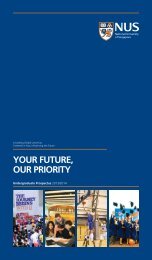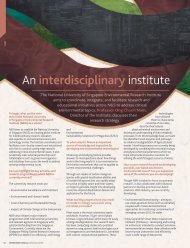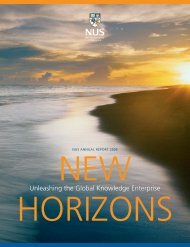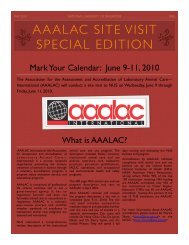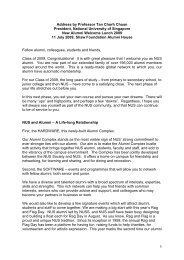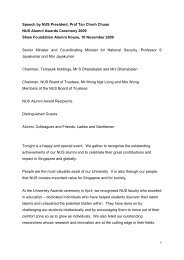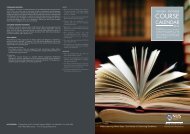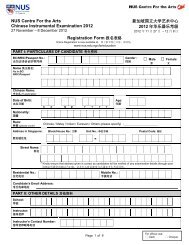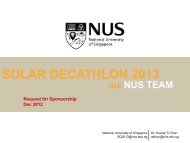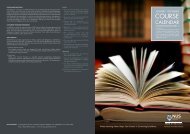SDC2013 - NUS - Home
SDC2013 - NUS - Home
SDC2013 - NUS - Home
You also want an ePaper? Increase the reach of your titles
YUMPU automatically turns print PDFs into web optimized ePapers that Google loves.
FOR INTERNAL CIRCULATION ONLY JAN/FEB 2012 ISSUE 1<br />
SPY!<br />
<strong>SDC2013</strong><br />
We bring you the latest update to the<br />
development of the solar house for Solar<br />
Decathlon China 2013<br />
542<br />
Natum vere numenis<br />
simus, od qui beribus siti<br />
con plautem<br />
CONFIDENTAL
Solar Decathlon China<br />
What does it mean for <strong>NUS</strong>?<br />
• It provides participating students with unique training that prepares them to enter the clean-energy<br />
workforce.<br />
The Solar Decathlon in 2011 provided more than 350000 house visits to the public over 10 days, offered 31<br />
workshops onsite for the public and held a dedicated day of six workshops for builders and industry, and<br />
reached millions of readers and viewers in markets across the globe through various media.<br />
<strong>NUS</strong> has been invited to the Solar Decathlon 2013 that will be taking place in Datong, China. By embarking<br />
on such a journey the students of <strong>NUS</strong> will experience what if feels like to work on an industrial sized<br />
project. Also student leadership is a key factor in this competition. By being part of this competition the<br />
students of <strong>NUS</strong> will learn how education is much more than what you learn in class and as a result will<br />
be more all-rounded to tackle problems they may encounter further in their career. Additionally it gives<br />
everyone a chance to learn more about other aspects of the competition even beyond the scope of their<br />
individual team.<br />
There are a total of 23 competing teams including <strong>NUS</strong> in the Solar Decathlon China 2013.<br />
Besides building the solar house for competition, the competition house will be brought back to Singapore,<br />
where it will form part of a bigger house. The completed house will be used as a platform for <strong>NUS</strong> to<br />
showcase the various existing green technologies!<br />
Solar analysis of a potential <strong>NUS</strong> scheme<br />
The U.S. Department of Energy Solar Decathlon challenges collegiate<br />
teams to design, build, and operate solar-powered houses that are costeffective,<br />
energy-efficient, and attractive. The winner of the competition<br />
is the team that best blends affordability, consumer appeal, and design<br />
excellence with optimal energy production and maximum efficiency.<br />
The solar decathlon has three main purposes:<br />
• To educate student participants and the public about the many cost-saving<br />
opportunities presented by clean energy products.<br />
• To demonstrate to the public the opportunities presented by cost-effectiveness<br />
houses that combine energy-efficient construction and appliances with renewable<br />
energy systems that are available today.<br />
<strong>SDC2013</strong> will be held<br />
in Datong, China<br />
23 teams<br />
36 universities<br />
13 countries<br />
CONFIDENTAL<br />
CONFIDENTAL
OUR PROJECT<br />
PHILOSOPHY<br />
Our mission is to design, build and operate a<br />
solar-powered home, with architects, builders<br />
and engineers collaborating from the inception<br />
concept to completion.<br />
Houses of previous<br />
Solar Decathlon<br />
editions<br />
While the focus of our efforts is on the local<br />
context, we aim to incorporate contemporary,<br />
innovative and sustainable design solutions,<br />
suitable for an urban and tropical setting, to<br />
address living-space constraints and climatic<br />
challenges.<br />
Being the first-ever project in <strong>NUS</strong> which<br />
spans across 3 faculties, 8 different<br />
departments, this project aims to<br />
bring out the best of everyone.<br />
Whether you are an architect,<br />
an engineer or someone who<br />
works quietly behind the<br />
scene, this project wants<br />
you to find an enjoyable<br />
and meaningful educational<br />
experience during the entire<br />
journey from inception to<br />
completion.<br />
Our goal is to achieve a house which<br />
showcases the various innovative green<br />
technologies , addressing space and<br />
climate constraints. Not just<br />
off-the-shelves commerical<br />
technologies. We want this<br />
house to be a spring-board for<br />
everyone to be an inventor.<br />
Be it the doors, PV or aircon<br />
systems, or even a simple<br />
change in the way we work,<br />
we want everyone to be creative<br />
problem solvers.<br />
CONFIDENTAL<br />
CONFIDENTAL
Who is competing?<br />
Let’s take a quick look at the universities participating in <strong>SDC2013</strong>!<br />
Sweden<br />
Chalmers University of Technology<br />
England-China<br />
London Metropolitan University and<br />
Guangzhou Academy of Fine Arts<br />
23 teams<br />
36 universities<br />
13 countries<br />
Switzerland-China<br />
Beijing Jiaotong University and Bern<br />
University of Applied Sciences<br />
China<br />
Shanghai Jiaotong University<br />
Xiamen University<br />
Xi’an University of Architecture<br />
and Technology<br />
China-United States<br />
Tsinghua University and Florida<br />
International University<br />
Peking University and University of<br />
Illinois at Urbana-Champaign<br />
Egypt<br />
American University in Cairo<br />
Malaysia<br />
Universiti Teknologi Malaysia<br />
Israel<br />
Tel Aviv University, Shenkar College of<br />
Engineering and Design<br />
Neri Bloomfield School of Design and<br />
Education<br />
College of Management Academic<br />
Studies<br />
Turkey<br />
Middle East Technical University<br />
SINGAPORE<br />
National University of Singapore<br />
Australia<br />
University of Wollongong<br />
CONFIDENTAL<br />
CONFIDENTAL
People<br />
Faculty Advisor<br />
Assistant Prof Huang Yi Chun<br />
Architecture<br />
civil eng.<br />
Env Science eng.<br />
Chen Yue Min Wynne<br />
Qin Ling<br />
Arnan Koh<br />
Chen Zhen Yu<br />
Yan Yan<br />
Chia Jui Sin Andy<br />
Cheng Xin Wei Julian<br />
Ritvik Dhupkar<br />
He Miao<br />
Clarence Fung<br />
Crystal Chew<br />
Farhana Hossain<br />
Goh Jia Li<br />
Ho Jing Yu Verna<br />
Joanne Gay<br />
Kelvin Phua<br />
Kew Xun Long<br />
Lim Xu Fen Brenda<br />
Lin YinYan Alvin<br />
May Goh Sok Hui<br />
Ng Kah Yee<br />
Seow Limin Averilyn<br />
Stephanie Wong Qing Ling<br />
Tan Hong Yang Jason<br />
Tan Yong Long Constans<br />
Terrence Ho XiYing<br />
Tristan Wu<br />
Wang Jue<br />
Xie Yang Lei<br />
Electrical eng.<br />
Li Xiong Yan<br />
Li Zheng Tian<br />
Peng Shujin<br />
Gao Wen Juan<br />
Maria Andriani<br />
Surjanto<br />
eng Science PRog<br />
Chen Lianwei<br />
Chen Yu<br />
Cheng Youyang<br />
Cindy Tang<br />
Ding Zhiwei<br />
Hou Chenxi<br />
Li Ning<br />
Luo Boyang<br />
Malcolm Ong Jin Yuan<br />
Michelle Julius<br />
Ngo Yun Fun<br />
Raghav Malhotra<br />
Teo MingHui<br />
FASs - economics<br />
Vasudha Thirani<br />
mechancial eng.<br />
Chew Wen Xuan<br />
Ho Jun De<br />
Huang Yu<br />
Lakshmi Balasubramaniam<br />
Lim Kean Onn<br />
Teo Tze Jie<br />
Chong Wil Ther<br />
Muhammad Hizam Bin Kamis<br />
Yugal Kasbekar<br />
pfm<br />
Chen Xiao Qing<br />
Le Vi Thanh<br />
Lee Kah Mun<br />
Ng Khoon Tze,<br />
Theodore<br />
external consultants<br />
Mr Kelvin Kan (AgFacaDesign)<br />
Ms Huay Xiaoxian (Huay Architects)<br />
Prof Joachim Luther (SERIS)<br />
Dr Khin Zaw (SERIS)<br />
Assoc Prof Stephen Wittkopf (SERIS)<br />
Dr Timothy Michael Walsh (SERIS)<br />
consulting faculty<br />
Assistant Prof Akshay Kumar Rathore<br />
Assistant Prof Benny Raphael<br />
Associate Prof Chandra Sekhar<br />
Senior Lecturer Cheah Kok Ming<br />
Associate Prof Christopher Yap<br />
Associate Prof Joseph Lim Ee man<br />
Assistant Prof Kua Harn Wei<br />
Senior Lecturer Lim Guan Tiong<br />
Professor Ng Kim Choon<br />
Assistant Prof Palani Balaya<br />
Assistant Prof Panida Jirutitijaroen<br />
Associate Prof Sanjib Kumar Panda<br />
Associate Prof Tse Swee Ling<br />
Yang Zhengzhi<br />
Nguyen Doong Binh<br />
Stewart Ko<br />
Tan Yoong Ying<br />
CONFIDENTAL<br />
CONFIDENTAL
Project timeline<br />
2012 2013<br />
feb mar apr may jun jul aug sep oct nov dec jan feb mar apr may jun jul aug sep oct nov dec<br />
20 April<br />
Schematic Design Proposal<br />
26 may<br />
Schematic Design Review<br />
Workshop (China)<br />
21 sep<br />
Design Development<br />
21 nov<br />
Design Development<br />
Review Workshop<br />
conceptual & schematic<br />
design<br />
design development<br />
construction documentation<br />
aug<br />
Competition<br />
prototype<br />
testing<br />
fabrication &<br />
construction<br />
testing &<br />
commissioning<br />
disassembly &<br />
ship to china<br />
ship to<br />
singapore<br />
set up nus<br />
facility<br />
CONFIDENTAL<br />
CONFIDENTAL
1 Architecture<br />
The overall architecture merits are<br />
assessed in this contest. Scales,<br />
proportions and composition of<br />
architectural elements are some of the<br />
components the jury look out for. Of<br />
course, are there any innovative and<br />
eco-friendly ways of using resources?<br />
Market Appeal<br />
2<br />
In this contest, the marketibilty<br />
and buildability are being assessed.<br />
Does the house meet the needs of the<br />
user? Is it comfortable and delightful<br />
to stay in? Lastly, are the drawing<br />
plans sufficiently documented for a<br />
contractor to estimate cost quickly?<br />
3 Engineering<br />
The engineering design merits<br />
are being assessed in this contest.<br />
How reliable are the systems? Do<br />
they function as intented? Are the<br />
implemented system useful in reducing<br />
energy cost? Lastly, are the engineering<br />
drawings and results accurate?<br />
?<br />
Decathlon<br />
noun<br />
Pronounced dih-kath-lon<br />
Greek origin, from δέκα (déka,<br />
meaning “ten”) and ἄθλος<br />
(áthlos, or ἄθλον, áthlon,<br />
meaning “ feat”)<br />
Traditionally, the title of<br />
“World’s Greatest Athlete” has<br />
been given to the man who wins<br />
the decathlon. This began when<br />
King Gustav V of Sweden told<br />
Jim Thorpe, “You, sir, are the<br />
world’s greatest athlete” after<br />
Thorpe won the decathlon at the<br />
Stockholm Olympics in 1912.<br />
4 Communications<br />
Website, public exhibit materials,<br />
presentation and video walkthrough<br />
are assessed in this contest. Do the<br />
materials appeal? Do they bring<br />
across the intended idea clearly and<br />
accurately?<br />
Yes, now you know that we are participating in the Solar Decathlon, but what does<br />
Decathlon mean?<br />
Check out our quick guide to the 10 contests...<br />
Source: wikipedia.com<br />
5 Solar<br />
application<br />
6 Comfort<br />
hot water<br />
7<br />
8 appliances<br />
9 home<br />
entertainment<br />
10 Energy<br />
balance<br />
Are the solar panels strategically<br />
placed? Are there innovative ways<br />
to utilize solar power? This contest<br />
is about good engineering practice<br />
and being ingenius! Lastly, are the<br />
solar systems economically sound to<br />
implement?<br />
Humans react badly to high<br />
temperature and high humidity. This<br />
contest requires the house to maintain<br />
a strict temperature range of 22°C to<br />
25°C and a low relative humidity of<br />
60%.<br />
A nice warm of coffee, a hot shower.<br />
What else can you ask for? This contest<br />
requires at least 60L of hot water of<br />
at least 45°C being discharged from<br />
the tap within 10 minutes. (PS. The<br />
water collected from the house is nonpotable,<br />
so please do not make coffee.)<br />
Think you can beat the game by using<br />
appliances with ultra-low power<br />
consumption? This contest tests the<br />
quality of the appliances; how well does<br />
it dry the clothes, is the freezer able to<br />
keep within the temperature range? It<br />
is a game of efficiency and quality.<br />
Now you have got your house, it’s time<br />
to invite your friends over for a party<br />
and a night movie! This contest tests<br />
how well does your house cope with the<br />
additional stress required to sustain a<br />
high-energy lifestyle. Of course, who<br />
would want a blackout in a party?<br />
Your party is over, you had all the<br />
fun. Now let’s see how much energy<br />
you have used over the 10 days. Are<br />
you a powerhouse or are you a power<br />
drainer? It determines if your house is<br />
a true solar house or just a marketing<br />
gimmick.<br />
CONFIDENTAL<br />
CONFIDENTAL
house!<br />
Modularity<br />
To address the issue on the urban density situation<br />
that has relevance in Asia, this design took on the challenge<br />
of Modularity. Re-configurability and flexibility are the<br />
ultimate goal of this design concept. Much like a “Lego” house,<br />
the designers have envisioned in creating a house which is made<br />
from a few fundamental elements. Different basic shapes<br />
of tiles, walls and glass panels. Much like the Legos,<br />
mixing them differently gives different results and<br />
Since the inauguration of the team in January 2012, our architecture students have been hard at work<br />
to design their ideal representation of a self sustaining solar house in an Asian context, while fusing<br />
in the notion of Architecture as Pedagogy. Before we look at the final design after the interim meeting<br />
on 18th February, let us look at the three designs our students have come up with.<br />
functionalities.<br />
the shell<br />
Covered with solar panels on every inch of the wall, this<br />
house is striking similar to the shell of a snail, the designers<br />
took a leaf from nature; creating a house which envelopes the<br />
users, keeping them sheltered and comfortable. The designers<br />
take on the challenge of indoor lightings as this house does<br />
not have windows.<br />
the spine<br />
A fairy tale of Architecture meets Technology. The designers<br />
decided to take on the challenge of integrating technology and<br />
pedagogy by expressing it through the spine of the architecture.<br />
The design also has a double skin system which acts as a<br />
protective layer, adapting and responding to every minute<br />
Interim meeting on 18th February<br />
changes the environment.<br />
CONFIDENTAL<br />
CONFIDENTAL
Where will it be located in<br />
<strong>NUS</strong>?<br />
The FINAL Design<br />
The Spine was eventually chosen for two main reasons, its buildability and the instructional value of the<br />
architecture. Although The Shell had massive potential and would bring an X-factor to the competition,<br />
We were worried about the constructional cost. Hence, the final design is an integration of the ideas of<br />
modularity and reconfigurability from the “Lego” house and the strong architecture expression of The<br />
Spine.<br />
The main expression of the final design is the two<br />
flaps providing solar protection; a critical necessity<br />
when building in the Tropics. These flaps also provide<br />
unobstructed flat surfaces for mounting PV panels.<br />
The Spine (coloured in blue above) not only functions<br />
as a transition space that separates the private and<br />
public spaces, but more importantly acts as a<br />
“pedagogy corridor” for exhibits and demostrations<br />
to educate the visitors on sustainable architecture.<br />
The design addresss both the competition<br />
requirements and usage post-competition in <strong>NUS</strong>.<br />
The design strategies and selected systems cater<br />
to climatic conditions in Datong and Singapore,<br />
competition contests, as well as educational needs<br />
upon return to Singapore.<br />
Remember the plot of land beside TechnoEdge? Initially, we wanted<br />
to located the solar house there for maximum student access, but this<br />
conflicted with OED green buffer plans. Currently, OED and the SDC<br />
team are working together to find suitable sites. We have discussed some<br />
seven sites including a plot of land near Prince George Park Residences,<br />
the junction of SDE and FASS. At this time, the proposed site is on the hillock in front<br />
of SDE 3.<br />
Floor plan of the house in Singapore<br />
CONFIDENTAL<br />
CONFIDENTAL
Site near prince george park residences<br />
Site near junction of sde and fass<br />
Site at Faculty of Engineering Site near carpark of sde 2 and sde 3<br />
* Current proposed site<br />
CONFIDENTAL<br />
CONFIDENTAL
Curriculum integration<br />
AR3104 Architecture Design<br />
Associate Professor Teh Kem Jin & Senior Lecturer Kazuhiro Nakajima<br />
The challenge of a comprehensive design and resolution required for real construction in the Solar Decathlon<br />
project makes it an ideal design brief for the year-3 architecture design studio, which demonstrates RIBA<br />
Part-1 competency in comprehensive architectural design skills; from planning to design and technical<br />
resolution. The original Solar Decathlon competition requirements are expanded with an emphasis for the<br />
house to be converted into a <strong>NUS</strong> Teaching Facility with pedagogical values upon return to Singapore, to<br />
add depth to the design-probem and context-response dimension, and focus environmental skills on tropical<br />
design. Armed with the experience and technical skills learnt using this Solar Decathlon design-brief, the<br />
Year-3 architecture students are better prepared for the incremental design challenges as they progress to<br />
upper years.<br />
AR4104 Architecture & Technology Design 2<br />
Assistant Professor Huang Yi Chun & Senior lecturer Cheah Kok Meng<br />
Similar to the design brief in the Year-3 studio (AR3104), the Year-4 architecture students are expected<br />
to provide more resolution in terms of design and technical proficiency for this module. Being part of<br />
the Design Technology & Sustainability (DTS) specialization, they are also expected to consider systems<br />
integration, and employ digital design processes to simulate and optimize design solutions. A particular<br />
focus is the introduction of the Integrated Design Process (IDP), where the students learn and practice<br />
IDP with participation from the rest of the Solar Decathlon Team, especially the engineering and project<br />
management students. The studio thus emphasizes understanding high performance architecture as a highly<br />
complex and integrative system as the result of an evidence-based approach, managing and creating design<br />
opportunities between multiple disciplines.<br />
Integration of competition effort into curriculum<br />
Due to the tight timeframe that we launched the Solar Decathlon effort, curriculum integration is still being<br />
discussed and set up; only few classes in SDE Department of Architecture have been integrated with the<br />
Solar Decathlon effort so far. We are working with various Engineering professors for possible curriculum<br />
integration next semester.<br />
AR2724 Designing with Environmental Systems<br />
Assistant Professor Huang Yi Chun<br />
The Solar Decathlon project is a good platform for the students to develop an understanding of fundamental<br />
building physics, the magnitude of challenge in achieving environmental performance in the tropics, and<br />
the design implications of systems necessary to deliver such performance. The design proposals in the Solar<br />
Decathlon project are integrated with the assignments in this class, where the students analyze thermal,<br />
lighting, and acoustic performances, and propose suitable and feasible design and system solutions.<br />
AR4322 Design Simulation & Analysis<br />
Assistant Profesor Huang Yi Chun (ongoing) & Dr Abel E. Tablada De La Torre (2012)<br />
The Solar Decathlon competition requirements complements the pedagogical objectives of this class to<br />
learn performance simulation tools (Radiance and EnergyPlus), and perform relevant analyzes to enable<br />
design development. The students begin with climatic studies of both Datong and Singapore and formulate<br />
base models to establish energy budgets and performance targets. After learning simulation and analytical<br />
methodologies, various design strategies from passive design to active systems are then simulated and<br />
analyzed in an integrated manner to synthesize a sustainable design solution. This class allows the Solar<br />
Decathlon team to better appreciate the nature and scope of the Solar Decathlon challenge (this being the<br />
first time <strong>NUS</strong> is participating in the competition), as well as prepare for required competition submissions.<br />
CONFIDENTAL<br />
CONFIDENTAL
Behind the scenes...<br />
AKi Hvac pv LVDC<br />
COMMS<br />
admin<br />
climate<br />
site<br />
EDUCATION!<br />
There are 8 large groups working on the various aspects of the project. The exact grouping will be decided at<br />
a later stage.<br />
In Education! we will sneak behind the scene and see what the various groups are doing. Plus we bring you<br />
exclusive interviews on their learning journey with <strong>SDC2013</strong>.<br />
CONFIDENTAL<br />
CONFIDENTAL
AKI<br />
Architecture<br />
The AKI team is responsible of the entire<br />
design of the house. The exterior of the<br />
house, the internal layout.<br />
What have they been<br />
working on?<br />
Brainstorming on various design concepts. Do, undo,<br />
redo and redo and redo... They came up with the 3<br />
design introduced earlier in the newsletter. Currently,<br />
they have selected the final design of the house, and they<br />
are working tightly with the engineers to integrate the<br />
various systems for the house.<br />
The design of the house does not stop there, they still<br />
have to do a full software design of the house. At the<br />
same time, they are analysing which sites are suitable as<br />
the permanent site of the house.<br />
Just recently, they did land surveying in <strong>NUS</strong>. They have<br />
been taking measurements, photos and doing up renders<br />
of the possible sites.<br />
“Do, undo, redo &<br />
redo & redo...<br />
”<br />
What did they learn?<br />
The competition brought in the ‘built for real’ factor that<br />
always been left out due to the academic nature of the<br />
school, which brings in more real time considerations<br />
like costing, and heavy discussions with non architecture<br />
members to give a integrated building solution.<br />
CONFIDENTAL<br />
CONFIDENTAL
hvac<br />
pv<br />
Air-conditioning and Ventilation<br />
Solar technologies<br />
The HVAC team, short for Heating,<br />
Ventilation, and Air-Conditioning, is<br />
responsible for the comfort element of the<br />
house.<br />
What have they been<br />
working on?<br />
To start designing an effective heating and cooling system,<br />
the HVAC team started by studying the past year winner’s<br />
HVAC strategy, while researching on new advanced<br />
technology in HVAC system. Armed with knowledge of the<br />
various HVAC systems, they are currently working on the<br />
details of each components, such as price, size and power<br />
consumption.<br />
In February, they visited SERIS dehumidification lab<br />
on campus. Applying what they have learnt in the<br />
ME2121(Engineering Thermodynamics), they read the<br />
psychometric chart and understood the theory behind it.<br />
The HVAC team also consulted Dr. Christopher Yap to<br />
gain insights on how to design an effective HVAC system,<br />
and what are the pitfalls.<br />
The PV team, short for Photovoltaics, is<br />
responsible for the solar technologies in<br />
the house.<br />
What have they been<br />
working on?<br />
As part of the Photovoltaic Team, they are in charge of<br />
designing the array of solar modules on the roof of the<br />
house that will provide electricity. The solar panels will be<br />
the main renewable energy source, if not the only renewable<br />
source of energy for the house.<br />
Currently, apart from working on case studies, they are<br />
looking at the different ways to configure the solar cells to<br />
maximize efficiency. Some of them are researching on the<br />
solar thermal aspect to provide for the hot water needs of<br />
the house.<br />
The solar system of the house ties in with the LVDC as well<br />
as the HVAC team.<br />
They are planning to invite Dr. Yap to be our supervisor to<br />
guide them through the whole design process.<br />
“ SERIS lab, desiccant<br />
wheel<br />
”<br />
What did they learn?<br />
They learnt how to calculate ventilation rate, heat exchange<br />
rate by lighting and ventilation, heat exchange rate by wall<br />
and window and so on. They have also explored the various<br />
HVAC technologies, which they could not have learnt from<br />
school.<br />
“ This competition<br />
really brings to life<br />
what we have learnt<br />
in class.<br />
”<br />
What did they learn?<br />
Through this project they hope to develop hands-on skills,<br />
as well as well as developing their soft skills and the ability<br />
to work in a team. “This competition really brings to life<br />
what we have learnt in class,” says Raghav, the leader of<br />
the PV team. For the Electrical and Engineering Science<br />
students as it is one thing to learn the theory behind power<br />
electronics and photovoltaics but it is a whole new matter to<br />
implement what we learned into practice.<br />
CONFIDENTAL<br />
CONFIDENTAL
lvdc<br />
COMMS<br />
Electricity grid<br />
Websites and communication<br />
The LVDC team, short for Low Voltage<br />
Direct Current, is responsible for the<br />
internal electricity grid in the house.<br />
What have they been<br />
working on?<br />
The LVDC team is working on the low voltage direct current<br />
system as well as residential appliances design. The biggest<br />
challenge they have been facing is that low voltage direct<br />
current system is a relatively new idea that they could not<br />
find any practical examples to reference to. They have been<br />
investing considerable amount of time on researching and<br />
investigating the feasibility of the system.<br />
The COMMS team, short for,<br />
Communications, is responsible for<br />
communicating the various ideas in<br />
the house and the project through the<br />
various channels - websites, videos and<br />
newsletters.<br />
What have they been<br />
working on?<br />
The COMMS team has been working day and night to<br />
establish the official website, blogs and newsletter (the one<br />
you are reading right now).<br />
Currently, the newsletter is the only communication<br />
medium ready, where you readers can get monthly updates<br />
of our <strong>SDC2013</strong> project development. Our websites and<br />
blogs are still being finalised before going online.<br />
For those enthusiatic readers who wants to be in the loop of<br />
every development, do keep a lookout on our blogs.<br />
“ The need to think<br />
about how to<br />
realize the idea,<br />
and implement<br />
them in the solar<br />
house<br />
”<br />
What did they learn?<br />
“In the Electrical Engineering curriculum, we are taught<br />
the theoretical knowledge, while in Solar Decathlon, we<br />
need to think about how to realize the idea, and implement<br />
them in the solar house,” says Wen Juan, the leader of the<br />
LVDC team.<br />
“<br />
Time management,<br />
time management,<br />
time management...<br />
”<br />
What did they learn?<br />
Time management, time management, time management.<br />
Design work is not an easy task, especially when you have<br />
tutorials to do as well. And of course, many little secrets as<br />
well.<br />
CONFIDENTAL<br />
CONFIDENTAL
climate<br />
admin<br />
Climate studies and strategies<br />
Administrative<br />
The CLIMATE team is responsible<br />
for studying and analysis the climate<br />
conditions in both Singapore and China,<br />
ensuring the best strategies are deployed in<br />
this house.<br />
“ Understanding<br />
the important role<br />
climate plays in<br />
house designs<br />
”<br />
What have they been<br />
working on?<br />
The CLIMATE team has been working alongside the<br />
AKI team to provide them with analyses of real data to<br />
substantiate the design. Taking raw data and arranging<br />
them into graphs and diagrams, this helps designers to<br />
understand the climatic patterns of our given site better.<br />
They took quantitative and qualitative surveys of areas in<br />
<strong>NUS</strong> which are naturally ventilated, so as to have a sense<br />
of what a thermally comfortable space is like. “This ensures<br />
that we keep in mind the human aspect when designing,”<br />
says Joanne, the leader of the CLIMATE team.<br />
Additionally, they have been working on a topographical<br />
site study using professional equipment on a proposed local<br />
site to map out the land features accurately.<br />
What did they learn?<br />
As the Climatic Team is composed of Architecture<br />
students from lower years, the job they have been doing<br />
directly impacts them, as they understand the important<br />
role climate plays in house designs. They have also been<br />
exposed to the tools which help them gain more insights<br />
into the climatic patterns of an area, and ultimately the<br />
design of the house.<br />
The ADMIN team, short for,<br />
Administrative, is responsible for keeping<br />
the project running, covering Human<br />
Resource and the various administrative<br />
works involved.<br />
“<br />
A whole new<br />
experience of<br />
understanding<br />
how Architects and<br />
Engineers work,<br />
something PFM<br />
students can hardly<br />
experience first<br />
hand<br />
”<br />
What have they been<br />
working on?<br />
Since the commencement of the Solar Decathlon project.<br />
The ADMIN team has been working fervently with meeting<br />
minutes, member list/particulars, attendance, HR matters,<br />
roles and responsibilities. This team is also called the<br />
documentation team, keeping track of the happenings in<br />
the entire project. Without them, things would be a little<br />
messy.<br />
Currently, they are still pulling everything together and set<br />
the ground right.<br />
“I am constantly looking to make it easier for the teams to<br />
contact each other. I believe that when the communication<br />
channels are clearer, information can be better conveyed<br />
to each other resulting in better teamwork and better<br />
integration of technological systems and architectural<br />
design. I believe that integration will be key in succeeding<br />
in this large project,” says Ming Hui, who is working on<br />
Human Resource in ADMIN.<br />
What did they learn?<br />
SD China has opened up a whole new experience of<br />
understanding how Architects and Engineers work,<br />
something Project and Facilities Management students can<br />
hardly experience first hand. “For example, I discovered the<br />
Architects passion to fuse their design with the user needs/<br />
satisfaction. And I felt the Engineers dedication to innovate,<br />
yet trying painstakingly, to ensure that their ideas work. All<br />
these are breathtaking,” says Stewart, the leader of ADMIN.<br />
CONFIDENTAL<br />
CONFIDENTAL
site<br />
Project and facilities management<br />
Milestones<br />
The ADMIN team, short for,<br />
Administrative, is responsible for keeping<br />
the project running, covering Human<br />
Resource and the various administrative<br />
works involved.<br />
What have they been<br />
working on?<br />
They are currently helping the ADMIN team with the<br />
necessary administrative works. In the coming months,<br />
they will be tasked on the job of overseeing the entire project<br />
management.<br />
18th February marks the first milestone of this project, when we had our interim meeting.<br />
Here is a brief overview of the happenings on that meeting.<br />
1Finalisation of<br />
architecture design<br />
We had the honour of having Ms<br />
Huay Xiaoxian, participant of Solar<br />
Decathlon 2007, for our interim<br />
meeting. During the meeting, we<br />
reviewed the three design concepts<br />
and settled on a final design. To have<br />
a more unique selling proposition,<br />
Ms Huay suggested that we<br />
incorporate elements of the house<br />
design which tackles problems we<br />
face in Singapore, such as space<br />
constraint.<br />
“<br />
No better experience<br />
than to get one’s<br />
hands dirty and to<br />
actually do it<br />
”<br />
What did they learn?<br />
A chance to work on something that is as real as the concrete<br />
and steel that goes into making the very foundations of the<br />
buildings that we live, work, and play in. While the textbook<br />
tells us what to do and how to do it, what the textbook<br />
does not teach is working with people from all different<br />
backgrounds, professions, and expertise. That comes from<br />
experience, and there can be no better experience than to<br />
get one’s hands dirty and to actually do it. The dynamics<br />
of working as a cohesive team is something that cannot be<br />
taught in a classroom. It has to be experienced, explored,<br />
and executed beyond the walls of a classroom.<br />
2Creation of mission<br />
statement<br />
With such a huge number of<br />
participants in this project, we<br />
needed a common objective and<br />
goal. As such, we came up with<br />
a mission statement which best<br />
describes our ultimate goal in this<br />
competition.<br />
3Proposal of<br />
engineering systems<br />
(PV, HVAC, EE)<br />
While the architecture students<br />
came up with design concepts, the<br />
3 engineering teams came up with<br />
their set of engineering strategies<br />
for the contests.<br />
4Precedence studies<br />
on past participants<br />
To better understand our<br />
competitors and the competition<br />
norms, each of the teams did their<br />
case studies, and presented their<br />
analysis on the participants of the<br />
past Solar Decathlon competitions.<br />
CONFIDENTAL<br />
CONFIDENTAL
Initiated by:<br />
Integrated Sustainability Solutions<br />
Cluster, Office of the Provost<br />
Faculty of Engineering<br />
School of Design and Environment<br />
We would like to thank the following sponsors:<br />
CONFIDENTAL



